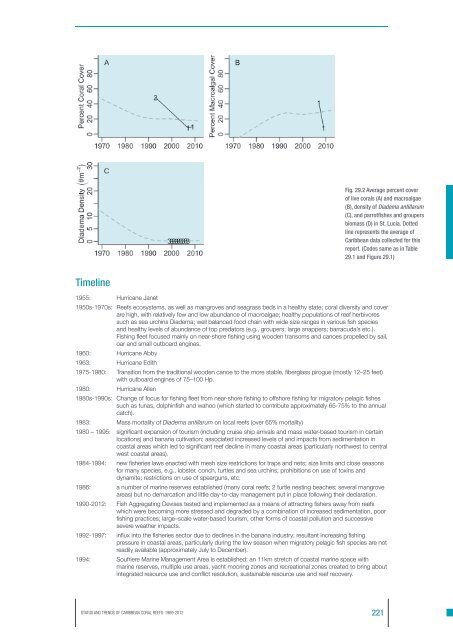Jackson2013-Status and Trendsof Caribbean Coral Reefs
Jackson2013-Status and Trendsof Caribbean Coral Reefs.pdf
Jackson2013-Status and Trendsof Caribbean Coral Reefs.pdf
Create successful ePaper yourself
Turn your PDF publications into a flip-book with our unique Google optimized e-Paper software.
Fig. 29.2 Average percent cover<br />
of live corals (A) <strong>and</strong> macroalgae<br />
(B), density of Diadema antillarum<br />
(C), <strong>and</strong> parrotfishes <strong>and</strong> groupers<br />
biomass (D) in St. Lucia. Dotted<br />
line represents the average of<br />
<strong>Caribbean</strong> data collected for this<br />
report. (Codes same as in Table<br />
29.1 <strong>and</strong> Figure 29.1)<br />
Timeline<br />
1955: Hurricane Janet<br />
1950s-1970s: <strong>Reefs</strong> ecosystems, as well as mangroves <strong>and</strong> seagrass beds in a healthy state; coral diversity <strong>and</strong> cover<br />
are high, with relatively few <strong>and</strong> low abundance of macroalgae; healthy populations of reef herbivores<br />
such as sea urchins Diadema; well balanced food chain with wide size ranges in various fish species<br />
<strong>and</strong> healthy levels of abundance of top predators (e.g., groupers; large snappers; barracuda’s etc.).<br />
Fishing fleet focused mainly on near-shore fishing using wooden transoms <strong>and</strong> canoes propelled by sail,<br />
oar <strong>and</strong> small outboard engines.<br />
1960: Hurricane Abby<br />
1963: Hurricane Edith<br />
1975-1980: Transition from the traditional wooden canoe to the more stable, fiberglass pirogue (mostly 12–25 feet)<br />
with outboard engines of 75–100 Hp.<br />
1980: Hurricane Allen<br />
1980s-1990s: Change of focus for fishing fleet from near-shore fishing to offshore fishing for migratory pelagic fishes<br />
such as tunas, dolphinfish <strong>and</strong> wahoo (which started to contribute approximately 65-75% to the annual<br />
catch).<br />
1983: Mass mortality of Diadema antillarum on local reefs (over 65% mortality)<br />
1980 – 1995: significant expansion of tourism (including cruise ship arrivals <strong>and</strong> mass water-based tourism in certain<br />
locations) <strong>and</strong> banana cultivation; associated increased levels of <strong>and</strong> impacts from sedimentation in<br />
coastal areas which led to significant reef decline in many coastal areas (particularly northwest to central<br />
west coastal areas).<br />
1984-1994: new fisheries laws enacted with mesh size restrictions for traps <strong>and</strong> nets; size limits <strong>and</strong> close seasons<br />
for many species, e.g., lobster, conch, turtles <strong>and</strong> sea urchins; prohibitions on use of toxins <strong>and</strong><br />
dynamite; restrictions on use of spearguns, etc.<br />
1986: a number of marine reserves established (many coral reefs; 2 turtle nesting beaches; several mangrove<br />
areas) but no demarcation <strong>and</strong> little day-to-day management put in place following their declaration.<br />
1990-2012: Fish Aggregating Devises tested <strong>and</strong> implemented as a means of attracting fishers away from reefs<br />
which were becoming more stressed <strong>and</strong> degraded by a combination of increased sedimentation, poor<br />
fishing practices; large–scale water-based tourism, other forms of coastal pollution <strong>and</strong> successive<br />
severe weather impacts.<br />
1992-1997: influx into the fisheries sector due to declines in the banana industry; resultant increasing fishing<br />
pressure in coastal areas, particularly during the low season when migratory pelagic fish species are not<br />
readily available (approximately July to December).<br />
1994: Soufriere Marine Management Area is established: an 11km stretch of coastal marine space with<br />
marine reserves, multiple use areas, yacht mooring zones <strong>and</strong> recreational zones created to bring about<br />
integrated resource use <strong>and</strong> conflict resolution, sustainable resource use <strong>and</strong> reef recovery.<br />
STATUS AND TRENDS OF CARIBBEAN CORAL REEFS: 1969-2012<br />
221


















